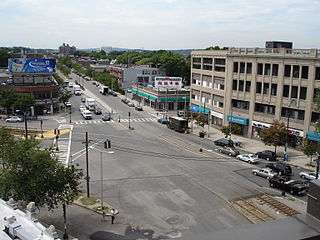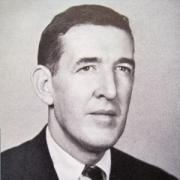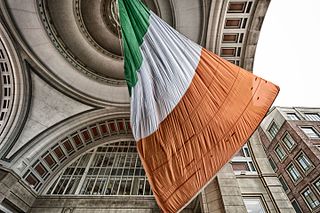
Five Points was a 19th-century neighborhood in Lower Manhattan, New York City. The neighborhood, partly built on low-lying land which had filled in the freshwater lake known as the Collect Pond, was generally defined as being bound by Centre Street to the west, the Bowery to the east, Canal Street to the north, and Park Row to the south. The Five Points gained international notoriety as a densely populated, disease-ridden, crime-infested slum which existed for over 70 years.

The North End is a neighborhood of Boston, Massachusetts. It has the distinction of being the city's oldest residential community, which has been inhabited since it was colonized in the 1630s. It is only 0.36 square miles (0.93 km2), yet the neighborhood has nearly one hundred establishments and a variety of tourist attractions. It is known for its Italian American population and Italian restaurants.

The Bowery is a street and neighborhood in Lower Manhattan in New York City, United States. The street runs from Chatham Square at Park Row, Worth Street, and Mott Street in the south to Cooper Square at 4th Street in the north. The eponymous neighborhood runs roughly from the Bowery east to Allen Street and First Avenue, and from Canal Street north to Cooper Square/East Fourth Street. The neighborhood roughly overlaps with Little Australia. To the south is Chinatown, to the east are the Lower East Side and the East Village, and to the west are Little Italy and NoHo. It has historically been considered a part of the Lower East Side of Manhattan.

Allston is an officially recognized neighborhood within the City of Boston, Massachusetts. It was named after the American painter and poet Washington Allston. It comprises the land covered by the zip code 02134. For the most part, Allston is administered collectively with the adjacent neighborhood of Brighton. The two are often referred to together as Allston–Brighton. Boston Police Department District D-14 covers the Allston-Brighton area and a Boston Fire Department Allston station is located in Union Square which houses Engine 41 and Ladder 14. Engine 41 is nicknamed "The Bull" to commemorate the historic stockyards of Allston.

William Foote Whyte was an American sociologist chiefly known for his ethnographic study in urban sociology, Street Corner Society. A pioneer in participant observation, he lived for four years in an Italian community in Boston while a Junior Fellow at Harvard researching social relations of street gangs in Boston's North End.

William Hollingsworth "Holly" Whyte Jr. was an American urbanist, sociologist, organizational analyst, journalist and people-watcher. He identified the elements that create vibrant public spaces within the city and filmed a variety of urban plazas in New York City in the 1970s. After his book about corporate culture The Organization Man (1956) sold over two million copies, Whyte turned his attention to the study of human behavior in urban settings. He published several books and a film on the topic, including The Social Life of Small Urban Spaces (1980).
Community studies is an academic field drawing on both sociology and anthropology and the social research methods of ethnography and participant observation in the study of community. In academic settings around the world, community studies is variously a sub-discipline of anthropology or sociology, or an independent discipline. It is often interdisciplinary and geared toward practical applications rather than purely theoretical perspectives. Community studies is sometimes combined with other fields, i.e., "Urban and Community Studies," "Health and Community Studies," or "Family and Community studies."

The West End is a neighborhood of Boston, Massachusetts, bounded generally by Cambridge Street to the south, the Charles River to the west and northwest, North Washington Street on the north and northeast, and New Sudbury Street on the east. Beacon Hill is to the south, North Point is across the Charles River to the north, Kendall Square is across the Charles River to the west, and the North End is to the east. A late 1950s urban renewal project razed a large Italian and Jewish enclave and displaced over 20,000 people in order to redevelop much of the West End and part of the neighboring Downtown neighborhood. After that, the original West End became increasingly non-residential, including part of Government Center as well as much of Massachusetts General Hospital and several high rise office buildings. More recently, however, new residential buildings and spaces, as well as new parks, have been appearing across the West End.
Herbert J. Gans is a German-born American sociologist who taught at Columbia University from 1971 to 2007.

Field research, field studies, or fieldwork is the collection of raw data outside a laboratory, library, or workplace setting. The approaches and methods used in field research vary across disciplines. For example, biologists who conduct field research may simply observe animals interacting with their environments, whereas social scientists conducting field research may interview or observe people in their natural environments to learn their languages, folklore, and social structures.

Elizabeth Strout is an American novelist and author. She is widely known for her works in literary fiction and her descriptive characterization. She was born and raised in Portland, Maine, and her experiences in her youth served as inspiration for her novels–the fictional "Shirley Falls, Maine" is the setting of four of her nine novels.

Uphams Corner, or Upham's Corner, is a commercial center in Dorchester, the largest neighborhood of Boston, Massachusetts. The intersection of Dudley Street/Stoughton Street and Columbia Road is the heart of Uphams Corner, and one of Dorchester's main business districts.
Social documentary photography or concerned photography is the recording of what the world looks like, with a social and/or environmental focus. It is a form of documentary photography, with the aim to draw the public's attention to ongoing social issues. It may also refer to a socially critical genre of photography dedicated to showing the life of underprivileged or disadvantaged people.

Christopher A. Iannella was a member of the Boston City Council in Boston, Massachusetts, for 33 years, spanning the late 1950s until his death. He also served eight one-year terms as City Council president.

Frederick Charles Langone was an American politician who served as a member of the Boston City Council from 1961 to 1971 and from 1973 to 1983. He was Council President in 1966. Langone, unofficially dubbed the mayor of the North End, was known as a defender of the "common guy" and an opponent of gentrification, as well as a budget expert who was extremely knowledgeable about the workings of city government. He was also known for his colorful personality.

People of Irish descent form the largest single ethnic group in Massachusetts, and one of the largest in Boston. Once a Puritan stronghold, Boston changed dramatically in the 19th century with the arrival of immigrants from other parts of the world. The Irish dominated the first wave of newcomers during this period, especially following the Great Irish Famine. Their arrival transformed Boston from an Anglo-Saxon, Protestant city into one that has become progressively more diverse. These people hired Irish as workers and servants, but there was little social interaction. In the 1840s and 50s, the anti-Catholic, anti-immigrant Know Nothing movement targeted Irish Catholics in Boston. In the 1860s, many Irish immigrants fought for the Union in the American Civil War, and that display of patriotism helped to dispel much of the prejudice against them.

Clementina Poto Langone (1896–1964) was a civic leader from the North End of Boston who is remembered for her service to the Italian-American community. During the Great Depression she was known as a "Good Samaritan" who distributed food and clothing to the poor and advocated for them politically. As a member of the Massachusetts Board of Immigration and Americanization, she helped hundreds of Italian immigrants assimilate and obtain U.S. citizenship. She served as vice chairman of the Massachusetts Democratic State Committee and as an alternate delegate to the Democratic National Convention.
Dead End is a stage play written by playwright Sidney Kingsley. It premiered on Broadway in October 1935 and ran for two years. It is notable for being the first project to feature the Dead End Kids, who would go on to star, under various names, in 89 films and three serials. These names include Dead End Kids, Little Tough Guys, the East Side Kids and the Bowery Boys. The original play and the 1937 film adaptation were grim dramas set in a poverty-stricken riverside neighborhood in New York City, where the boys look on reform school as a learning opportunity. They played similar characters in several films; their later pictures are comedies.

Joseph A. Langone Jr. (1896–1960) was a Massachusetts state senator from 1933 to 1940, and was Boston Election Commissioner in the 1940s.
Not all of the 5 million Italians who immigrated to the United States between 1820 and 1978 came through Ellis Island. Many came through other ports, including the Port of Boston. Exactly how many stayed in Boston is unknown, but it was enough to make Italians the second largest ancestry group in Boston, after the Irish. Most settled initially in the North End; others settled in East Boston, the West End, Roxbury, and other neighborhoods. These groups of Italians now mainly reside in the suburbs mostly north/northwest of the city. But the North end and Eastie still retain much of there Italian culture.















